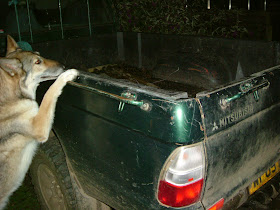Actually, I think the term harvest only applies if I've grown it myself. Otherwise I think it's foraging. Free spoils. Like finding a great chair on the curbside with a 'free' sign on it.
There's been a good show of fungi. We found a much-coveted prize: the giant puffball.
I think puffballs are coveted because of their size and ephemeral nature, and not their amazing flavor. It was palatable, although the texture is somehwere between a marshmallow and a nerf ball. I managed a few slices fried in butter and garlic on toast, but composted the rest. Next time I see one in a field, I might pretend that I didn't.
The pony paddock is awash in field mushrooms, which I pick as button size. They're your workaday mushrooms, nothing fancy like a shiitake or oyster, but they sure can bulk out a curry or an omelette. We've been eating those on an almost daily basis, while stocks last as they say.
All my harvests get collected in a horse feed bucket - is that in any way hygienic?
I guess the nature of foraging is the gamble. After you're sure it's not poisonous, then it's all personal preference. Having a good repertoire of cooking skills and appropriate recipes probably stacks the deck in your favor. A puffball in the hands of a decent chef who knows how to work with its nerfball-like qualities might have made all the difference. Where even a amateur like me can muster up a passable chicken and field mushroom casserole.
I caught the crabapple crop just right this year. Crabapple jelly is a staple in our pantry and I have a bucketful of fruit to process. My favorite variety is Malus 'Dartmouth' and the one tree I know of is some 20 miles away in a public garden. Foraging for these apples verges on stealing, though I only pick up the windfalls. I tell myself that I'm simply clearing them up for the gardening staff. That will also be my defense in court.
Still life with crabapples and puffball in horse bucket
I thought I would collect a few hazelnuts this year too, as I enjoyed the foraged sweet chestnuts last year. I envision rich chocolate hazelnut puddings (wearing sweaters means I can eat as many as I want). I thought I would do double duty: take the horses for a ride and pick nuts as I went. On horseback I could reach the higher branches. I put some panniers on Alan and expected to come back from our ride with both sides full. I was congratulating myself on my efficiency and genius.
I didn't know horses like hazelnuts too, or that they're quicker than me at finding them.
One for me...six for you...
When I stopped at a tree to pick the nuts, Alan and Kitty joined in. For every one I found and picked, they ate a branch with several clusters on it. I only managed a few meagre handfuls in total. They ate their fill. Equine ingrates.
The hazelnuts will be around for a bit longer so my dreams of puddings and muffin tops aren't wholly lost. To improve my chances, I won't be taking the horses with me next time. But I'll still have to do battle with the squirrels and my money's on them. I'll accept my fate. As long as I don't have to live on puffballs.























